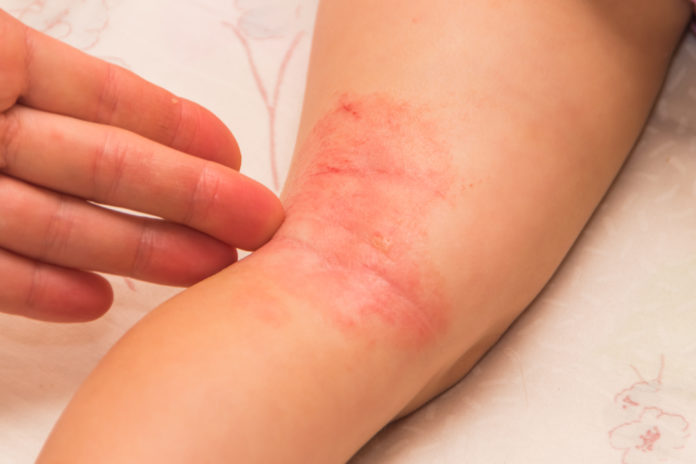
In the UK, one in five babies and children get eczema, otherwise known as ‘Dermatitis’. Eczema is an itchy, inflammatory skin condition. It can cause a great deal of distress in families.
The most common type is called ‘Atopic Eczema’. Atopic eczema tends to run in families and it may be linked to /pet/environmental allergies, and if your child has this kind of eczema it is far more likely that he or she may get asthma, hay-fever or food allergies. Eczema can be ‘mild, moderate or severe’, and treatment depends on how severe it is. For mild eczema most treatments can be bought over-the-counter.
Atopic eczema causes ‘flare-ups’ of red, itchy, inflamed skin, which may feel rough to touch. In babies it can affect the face, arms, legs and body, and in older children it is seen on the backs of the knees and the crease of the elbows.
What Causes Eczema?
In atopic eczema the skin is less oily and moisturised than normal. Often this is because one of your genes that produces moisture on the skin is not working properly. This leads to dry skin and inflammation. It can also be made worse by hard water, soap products and pollen or having some food allergies. Other things making eczema worse include experiencing a change in temperature. Bubble baths, bath and skin products, clothing such as wool or synthetics, or chemicals e.g. swimming pool chlorine, can also make eczema worse.
Tiny mites that live in dust inside every house can trigger a flare-up of eczema. It is a good idea to keep symptom diary if you are noticing something that may be triggering your child’s eczema.
Eczema in very young babies may be linked to cow’s milk protein allergy.
How to treat eczema?
The mainstay of treatment is moisturising the skin. Most importantly, regular and thick application of moisturiser can reduce the requirement for steroids by 40%.
‘Emollient’ (good quality moisturisers made for dry skin conditions) are all available to buy over-the-counter (even the ones prescribed by doctors), and there is a lot of choice. Emollients are commonly found in the form of a cream or ointment but can be gels or lotions. Creams easily absorb into the skin and ointments take longer. If you use an ointment in a tub it’s important not to put your fingers into the tub as this can introduce bacteria. Use a clean spoon to remove what is required. Remember, emollients containing paraffin are flammable.
Putting oils on the skin is not the best way to moisturise. (There are other benefits of using oil, e.g. Olive oil can be used for giving the baby a massage or removing cradle cap.) For babies under 6 months, putting food-based oils on the skin can sometimes lead to ‘sensitisation’ and allergies later. It is therefore best to avoid coconut oils, and oat-based products such as Aveeno, before weaning.
Dry, cracked, or damaged skin is an ‘entry point’ for allergies, so it is very important to keep the skin as healthy as possible. If you have a family history of eczema, it is a good idea, even if the baby’s not yet showing signs of eczema, to use a good quality moisturise on your baby once a day. That should help keep the skin healthy.
At bath-times you can emollients instead of soap, and a bath oil could be added to the water, as water itself is drying to the skin.
Top tips for using emollients:
- Wash your hands before applying the emollient to reduce bacteria transmission
- Apply the cream or ointment thickly in a downward motion, and avoid rubbing the cream in
- Continue to use emollients even when the skin has no eczema; this will help prevent flare-ups
- If using steroids ensure a 30-minute gap between the steroid application and the emollient (you can apply them in either order)
- Using an emollient as a soap substitute – apply the cream to the body just before the bath and then wash it off in the bath
- Apply emollients soon after getting out of the bath – ‘Soak and Seal’
- Use emollients as frequently as possible during flare ups. Experts suggest doing it at least 3 times a day smearing it over all areas thickly.
Steroid treatment
Steroid creams or ointments are used to treat flare-ups of eczema where the skin is red and inflamed. Depending on the severity of eczema, a steroid of varying strength may be recommended and prescribed by your doctor. Mild steroids e.g. Hydrocortisone 1%, are available to buy over-the-counter. Steroid creams should be used under guidance of the pharmacist or medical professional. Using steroid creams can effectively control an eczema flare-up and it’s important to see a medical professional for anything more than mild eczema.
Other treatments for severe eczema do exist but are not covered in this article.
Infection
Eczema can also get infected, and it is important to see a healthcare professional if there is:
- Oozing or weeping from eczema
- Yellow crusts
- Painful skin
- Eczema flare-up and a high temperature.
The main message is: moisturising your baby or child’s skin regularly will make eczema much easier to manage.
BY Dr Laura David

MBChB, BSc, MRCS
Founder and Director of Smart About HealthDr David is a General Practice Registrar in North London and mother of two. She delivers health education workshops and events for parents and parents-to-be via her business, Smart About Health. These workshops are available to individuals, groups, organisations and corporates. To arrange a workshop/educational event for yourself or your organisation, contact laura@smartabouthealth.co.uk or via the website www.smartabouthealth.co.uk
COPYRIGHT – Dr Laura David 2019The content of this article may not be reproduced without consent of the author, Dr Laura David









